Sporulation Strategies and Potential Role of the Exosporium in Survival and Persistence of Clostridium botulinum
Abstract
1. Introduction
2. Results
2.1. Sporulation Dynamics
2.2. Ultrastructure of Sporulating Cells and Spores
2.3. Spore Autoaggregation, Sedimentation, and Hydrophobicity
2.4. Thermal Destruction of Spores
3. Discussion
4. Materials and Methods
4.1. Bacterial Strains and Growth Conditions
4.2. Phase Contrast Microscopy
4.3. Spore Purification
4.4. Transmission Electron Microscopy (TEM)
4.5. Spore Measurements in Thin Section Samples
4.6. Spore Autoaggregation
4.7. Spore Hydrophobicity
4.8. Spore Heat Resistance
Supplementary Materials
Author Contributions
Funding
Institutional Review Board Statement
Informed Consent Statement
Data Availability Statement
Acknowledgments
Conflicts of Interest
References
- Lindström, M.; Korkeala, H. Laboratory diagnostics of botulism. Clin. Microbiol. Rev. 2006, 19, 298–314. [Google Scholar] [CrossRef] [PubMed]
- Peck, M.W. Biology and genomic analysis of Clostridium botulinum. Adv. Microb. Physiol. 2009, 55, 183–265, 320. [Google Scholar] [CrossRef] [PubMed]
- Espelund, M.; Klaveness, D. Botulism outbreaks in natural environments—An update. Front. Microbiol. 2014, 5, 287. [Google Scholar] [CrossRef]
- Brook, I. Infant botulism. J. Perinatol. 2007, 27, 175–180. [Google Scholar] [CrossRef]
- Sevenier, V.; Delannoy, S.; André, S.; Fach, P.; Remize, F. Prevalence of Clostridium botulinum and thermophilic heat-resistant spores in raw carrots and green beans used in French canning industry. Int. J. Food Microbiol. 2012, 155, 263–268. [Google Scholar] [CrossRef]
- Zhorzholiani, E.; Chakvetadze, N.; Katsitadze, G.; Imnadze, P. Spread of Clostridium botulinum in the soils of Georgia. Online J. Public Health Inform. 2017, 9, e160. [Google Scholar] [CrossRef]
- McCroskey, L.M.; Hatheway, C.L. Laboratory findings in four cases of adult botulism suggest colonization of the intestinal tract. J. Clin. Microbiol. 1988, 26, 1052–1054. [Google Scholar] [CrossRef]
- Pflug, I.J. Science, practice, and human errors in controlling Clostridium botulinum in heat-preserved food in hermetic containers. J. Food Prot. 2010, 73, 993–1002. [Google Scholar] [CrossRef]
- Lindström, M.; Kiviniemi, K.; Korkeala, H. Hazard and control of Group II (non-proteolytic) Clostridium botulinum in modern food processing. Int. J. Food Microbiol. 2006, 108, 92–104. [Google Scholar] [CrossRef] [PubMed]
- Songer, J.G. Chapter 10—Clostridial diseases of animals. In The Clostridia; Rood, J.I., McClane, B.A., Songer, J.G., Titball, R.W., Eds.; Academic Press: San Diego, CA, USA, 1997; pp. 153–182. [Google Scholar]
- Brett, M.M.; Hallas, G.; Mpamugo, O. Wound botulism in the UK and Ireland. J. Med. Microbiol. 2004, 53, 555–561. [Google Scholar] [CrossRef]
- (CDC) Centers for Disease Control and Prevention. Botulism Annual Summary, 2018; U.S. Department of Health and Human Services, CDC: Atlanta, GA, USA, 2021.
- Piggot, P.J.; Hilbert, D.W. Sporulation of Bacillus subtilis. Curr. Opin. Microbiol. 2004, 7, 579–586. [Google Scholar] [CrossRef] [PubMed]
- Pereira, F.C.; Saujet, L.; Tomé, A.R.; Serrano, M.; Monot, M.; Couture-Tosi, E.; Martin-Verstraete, I.; Dupuy, B.; Henriques, A.O. The spore differentiation pathway in the enteric pathogen Clostridium difficile. PLoS Genet 2013, 9, e1003782. [Google Scholar] [CrossRef] [PubMed]
- Errington, J. Bacillus subtilis sporulation: Regulation of gene expression and control of morphogenesis. Microbiol. Rev. 1993, 57, 1. [Google Scholar] [CrossRef] [PubMed]
- Henriques, A.O.; Moran, C.P., Jr. Structure, assembly, and function of the spore surface layers. Annu. Rev. Microbiol. 2007, 61, 555–588. [Google Scholar] [CrossRef]
- Kirk, D.G.; Zhang, Z.; Korkeala, H.; Lindström, M. Alternative sigma factors SigF, SigE, and SigG are essential for sporulation in Clostridium botulinum ATCC 3502. Appl. Environ. Microbiol. 2014, 80, 5141. [Google Scholar] [CrossRef][Green Version]
- Kirk, D.G.; Dahlsten, E.; Zhang, Z.; Korkeala, H.; Lindström, M. Involvement of Clostridium botulinum ATCC 3502 sigma factor K in early-stage sporulation. Appl. Environ. Microbiol. 2012, 78, 4590. [Google Scholar] [CrossRef]
- Selby, K.; Mascher, G.; Somervuo, P.; Lindström, M.; Korkeala, H. Heat shock and prolonged heat stress attenuate neurotoxin and sporulation gene expression in Group I Clostridium botulinum strain ATCC 3502. PLoS ONE 2017, 12, e0176944. [Google Scholar] [CrossRef] [PubMed]
- Mascher, G.; Mertaoja, A.; Korkeala, H.; Lindström, M. Neurotoxin synthesis is positively regulated by the sporulation transcription factor Spo0A in Clostridium botulinum type E. Environ. Microbiol 2017, 19, 4287–4300. [Google Scholar] [CrossRef]
- Odlaug, T.E.; Pflug, I.J. Thermal destruction of Clostridium botulinum spores suspended in tomato juice in aluminum thermal death time tubes. Appl. Environ. Microbiol. 1977, 34, 23–29. [Google Scholar] [CrossRef] [PubMed]
- Kim, J.; Foegeding, P.M. Principles of control. In Clostridium botulinum Ecology and Control in Foods; Hauschild, A.H.W., Dodds, K.L., Eds.; Marcel Dekker, Inc.: New York, NY, USA, 1993; pp. 121–176. [Google Scholar]
- Brunt, J.; van Vliet, A.H.M.; van den Bos, F.; Carter, A.T.; Peck, M.W. Diversity of the germination apparatus in Clostridium botulinum Groups I, II, III, and IV. Front. Microbiol. 2016, 7, 1702. [Google Scholar] [CrossRef]
- Burns, D.A.; Minton, N.P. Sporulation studies in Clostridium difficile. J. Microbiol. Methods 2011, 87, 133–138. [Google Scholar] [CrossRef]
- Mutlu, A.; Kaspar, C.; Becker, N.; Bischofs, I.B. A spore quality–quantity tradeoff favors diverse sporulation strategies in Bacillus subtilis. ISME J. 2020, 14, 2703–2714. [Google Scholar] [CrossRef]
- Mertaoja, A.; Nowakowska, M.B.; Mascher, G.; Heljanko, V.; Groothuis, D.; Minton, N.P.; Lindström, M. CRISPR-Cas9-based toolkit for Clostridium botulinum Group II spore and sporulation research. Front. Microbiol. 2021, 12, 617269. [Google Scholar] [CrossRef] [PubMed]
- Stewart, G.C. The exosporium layer of bacterial spores: A connection to the environment and the infected host. Microbiol. Mol. Biol. Rev. 2015, 79, 437–457. [Google Scholar] [CrossRef] [PubMed]
- Rabi, R.; Turnbull, L.; Whitchurch, C.B.; Awad, M.; Lyras, D. Structural characterization of Clostridium sordellii spores of diverse human, animal, and environmental origin and comparison to Clostridium difficile spores. mSphere 2017, 2, e00343-17. [Google Scholar] [CrossRef] [PubMed]
- Stevenson, K.E.; Vaughn, R.H. Exosporium formation in sporulating cells of Clostridium botulinum 78A. J. Bacteriol. 1972, 112, 618–621. [Google Scholar] [CrossRef]
- Hodgkiss, W.; Ordal, Z.J. Morphology of the spore of some strains of Clostridium botulinum type E. J. Bacteriol. 1966, 91, 2031–2036. [Google Scholar] [CrossRef]
- Takagi, A.; Kawata, T.; Yamamoto, S. Electron microscope studies on ultrathin sections of spores of the Clostridium group, with special reference to the sporulation and germination process. J. Bacteriol. 1960, 80, 37–46. [Google Scholar] [CrossRef]
- Dorken, G.; Ferguson, G.P.; French, C.E.; Poon, W.C. Aggregation by depletion attraction in cultures of bacteria producing exopolysaccharide. J. R. Soc. Interface 2012, 9, 3490–3502. [Google Scholar] [CrossRef]
- Rosenberg, M.; Gutnick, D.; Rosenberg, E. Adherence of bacteria to hydrocarbons: A simple method for measuring cell-surface hydrophobicity. FEMS Microbiol. Lett. 1980, 9, 29–33. [Google Scholar] [CrossRef]
- Krasowska, A.; Sigler, K. How microorganisms use hydrophobicity and what does this mean for human needs? Front. Cell Infect. Microbiol. 2014, 4, 112. [Google Scholar] [CrossRef]
- Collado, M.C.; Meriluoto, J.; Salminen, S. Adhesion and aggregation properties of probiotic and pathogen strains. Eur. Food Res. Technol. 2008, 226, 1065–1073. [Google Scholar] [CrossRef]
- Trunk, T.; Khalil, H.S.; Leo, J.C. Bacterial autoaggregation. AIMS Microbiol. 2018, 4, 140–164. [Google Scholar] [CrossRef]
- Williams, G.; Linley, E.; Nicholas, R.; Baillie, L. The role of the exosporium in the environmental distribution of anthrax. J. Appl. Microbiol. 2013, 114, 396–403. [Google Scholar] [CrossRef]
- Lequette, Y.; Garénaux, E.; Tauveron, G.; Dumez, S.; Perchat, S.; Slomianny, C.; Lereclus, D.; Guérardel, Y.; Faille, C. Role played by exosporium glycoproteins in the surface properties of Bacillus cereus spores and in their adhesion to stainless steel. Appl. Environ. Microbiol. 2011, 77, 4905–4911. [Google Scholar] [CrossRef]
- Joshi, L.T.; Phillips, D.S.; Williams, C.F.; Alyousef, A.; Baillie, L. Contribution of spores to the ability of Clostridium difficile to adhere to surfaces. Appl. Environ. Microbiol. 2012, 78, 7671–7679. [Google Scholar] [CrossRef]
- Calderón-Romero, P.; Castro-Córdova, P.; Reyes-Ramírez, R.; Milano-Céspedes, M.; Guerrero-Araya, E.; Pizarro-Guajardo, M.; Olguín-Araneda, V.; Gil, F.; Paredes-Sabja, D. Clostridium difficile exosporium cysteine-rich proteins are essential for the morphogenesis of the exosporium layer, spore resistance, and affect C. difficile pathogenesis. PLoS Pathog. 2018, 14, e1007199. [Google Scholar] [CrossRef] [PubMed]
- Antunes, W.; Pereira, F.C.; Feliciano, C.; Saujet, L.; Vultos, T.d.; Couture-Tosi, E.; Péchiné, S.; Bruxelle, J.-F.; Janoir, C.; Melo, L.V.; et al. Structure and assembly of a Clostridioides difficile spore polar appendage. bioRxiv 2018, 468637. [Google Scholar] [CrossRef]
- Takagi, A.; Kawata, T.; Yamamoto, S.; Kubo, T.; Okita, S. Electron microscopic studies on ultrathin sections of spores of Clostridium tetani and Clostridium histolyticum, with special reference to sporulation and spore germination process. Jpn. J. Microbiol. 1960, 4, 137–155. [Google Scholar] [CrossRef] [PubMed]
- Fitz-James, P.C. Morphology of spore development in Clostridium pectinovorum. J. Bacteriol. 1962, 84, 104–114. [Google Scholar] [CrossRef]
- Mackey, B.M.; Morris, J.G. Ultrastructural changes during sporulation in Clostridium pasteurianum. J. Gen. Microbiol. 1970, 63, 13. [Google Scholar] [CrossRef][Green Version]
- Pope, L.; Rode, L.J. Spore fine structure in Clostridium cochlearium. J. Bacteriol. 1969, 100, 994–1001. [Google Scholar] [CrossRef] [PubMed]
- Driks, A. Bacillus subtilis spore coat. Microbiol. Mol. Biol. Rev. 1999, 63, 1–20. [Google Scholar] [CrossRef]
- Janganan, T.K.; Mullin, N.; Dafis-Sagarmendi, A.; Brunt, J.; Tzokov, S.B.; Stringer, S.; Moir, A.; Chaudhuri, R.R.; Fagan, R.P.; Hobbs, J.K.; et al. Architecture and self-assembly of Clostridium sporogenes and Clostridium botulinum spore surfaces illustrate a general protective strategy across spore formers. mSphere 2020, 5, e00424-20. [Google Scholar] [CrossRef] [PubMed]
- Janganan, T.K.; Mullin, N.; Tzokov, S.B.; Stringer, S.; Fagan, R.P.; Hobbs, J.K.; Moir, A.; Bullough, P.A. Characterization of the spore surface and exosporium proteins of Clostridium sporogenes; implications for Clostridium botulinum group I strains. Food Microbiol. 2016, 59, 205–212. [Google Scholar] [CrossRef]
- Wiencek, K.M.; Klapes, N.A.; Foegeding, P.M. Hydrophobicity of Bacillus and Clostridium spores. Appl. Environ. Microbiol. 1990, 56, 2600. [Google Scholar] [CrossRef]
- Segner, W.P.; Schmidt, C.F. Heat resistance of spores of marine and terrestrial strains of Clostridium botulinum type C. Appl. Microbiol. 1971, 22, 1030–1033. [Google Scholar] [CrossRef]
- Skarin, H.; Lindberg, A.; Blomqvist, G.; Aspán, A.; Båverud, V. Molecular characterization and comparison of Clostridium botulinum type C avian strains. Avian Pathol. 2010, 39, 511–518. [Google Scholar] [CrossRef]
- Smith, T.J.; Hill, K.K.; Foley, B.T.; Detter, J.C.; Munk, A.C.; Bruce, D.C.; Doggett, N.A.; Smith, L.A.; Marks, J.D.; Xie, G.; et al. Analysis of the neurotoxin complex genes in Clostridium botulinum A1–A4 and B1 strains: BoNT/A3, /Ba4 and /B1 clusters are located within plasmids. PLoS ONE 2007, 2, e1271. [Google Scholar] [CrossRef]
- Derman, Y.; Korkeala, H.; Salo, E.; Lönnqvist, T.; Saxen, H.; Lindström, M. Infant botulism with prolonged faecal excretion of botulinum neurotoxin and Clostridium botulinum for 7 months. Epidemiol. Infect. 2014, 142, 335–339. [Google Scholar] [CrossRef] [PubMed]
- Jalava, K.; Selby, K.; Pihlajasaari, A.; Kolho, E.; Dahlsten, E.; Forss, N.; Bäcklund, T.; Korkeala, H.; Honkanen-Buzalski, T.; Hulkko, T.; et al. Two cases of food-borne botulism in Finland caused by conserved olives, October 2011. Euro Surveill. 2011, 16, 20034. [Google Scholar] [CrossRef] [PubMed]
- Stringer, S.C.; Carter, A.T.; Webb, M.D.; Wachnicka, E.; Crossman, L.C.; Sebaihia, M.; Peck, M.W. Genomic and physiological variability within Group II (non-proteolytic) Clostridium botulinum. BMC Genom. 2013, 14, 333. [Google Scholar] [CrossRef]
- Anonymous. Sample from Clostridium botulinum E1 Str. ‘BoNT E Beluga’. Available online: https://www.ncbi.nlm.nih.gov/biosample/?term=txid536233[Organism:noexp (accessed on 22 July 2021).
- Lindström, M.; Hielm, S.; Nevas, M.; Tuisku, S.; Korkeala, H. Proteolytic Clostridium botulinum type B in the gastric content of a patient with type E botulism due to whitefish eggs. Foodborne Pathog. Dis. 2004, 1, 53–57. [Google Scholar] [CrossRef] [PubMed]
- Skarin, H.; Håfström, T.; Westerberg, J.; Segerman, B. Clostridium botulinum group III: A group with dual identity shaped by plasmids, phages and mobile elements. BMC Genom. 2011, 12, 185. [Google Scholar] [CrossRef] [PubMed]
- Henriques, A.O.; Melsen, L.R.; Moran, C.P., Jr. Involvement of superoxide dismutase in spore coat assembly in Bacillus subtilis. J. Bacteriol. 1998, 180, 2285–2291. [Google Scholar] [CrossRef] [PubMed]
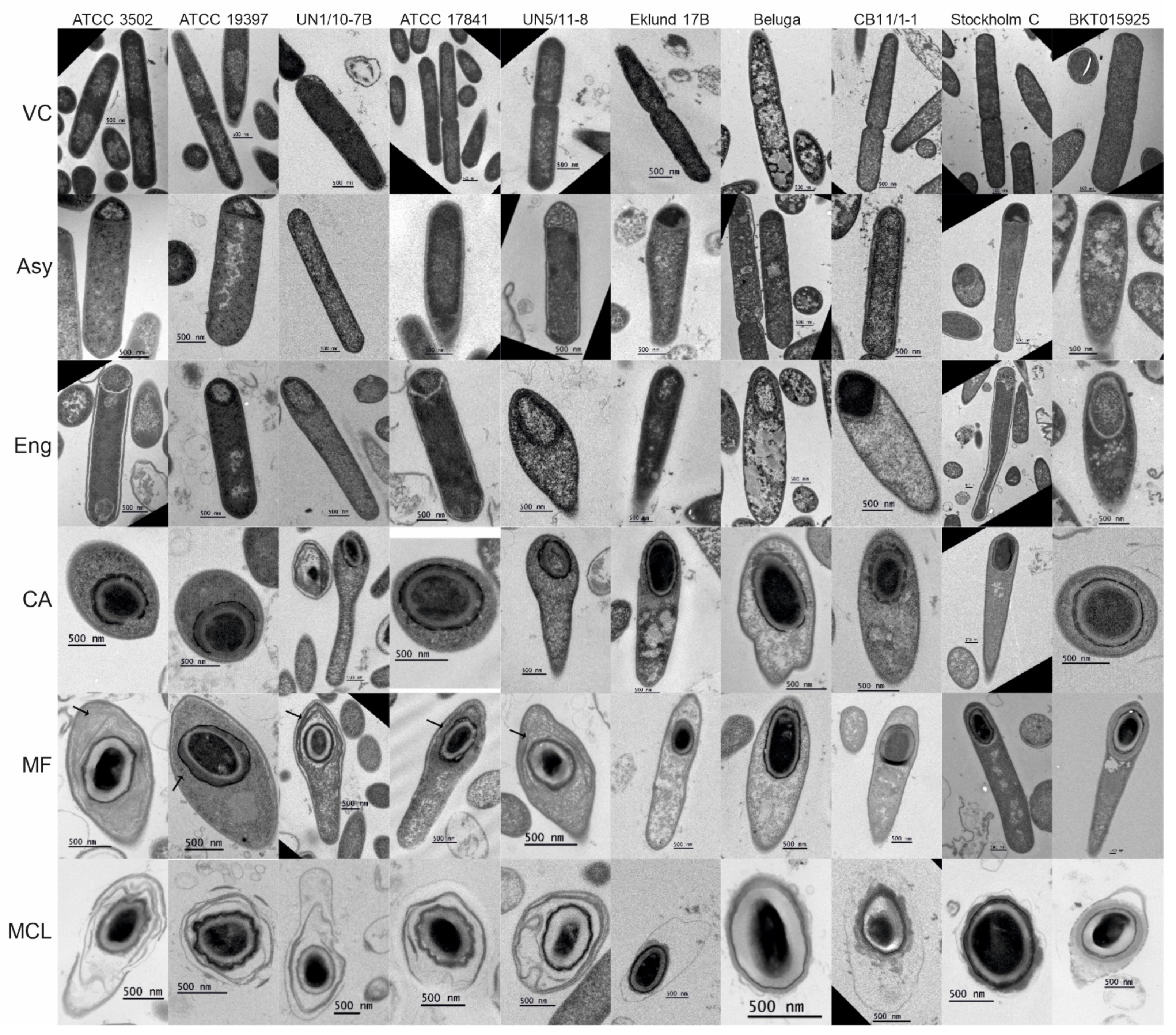
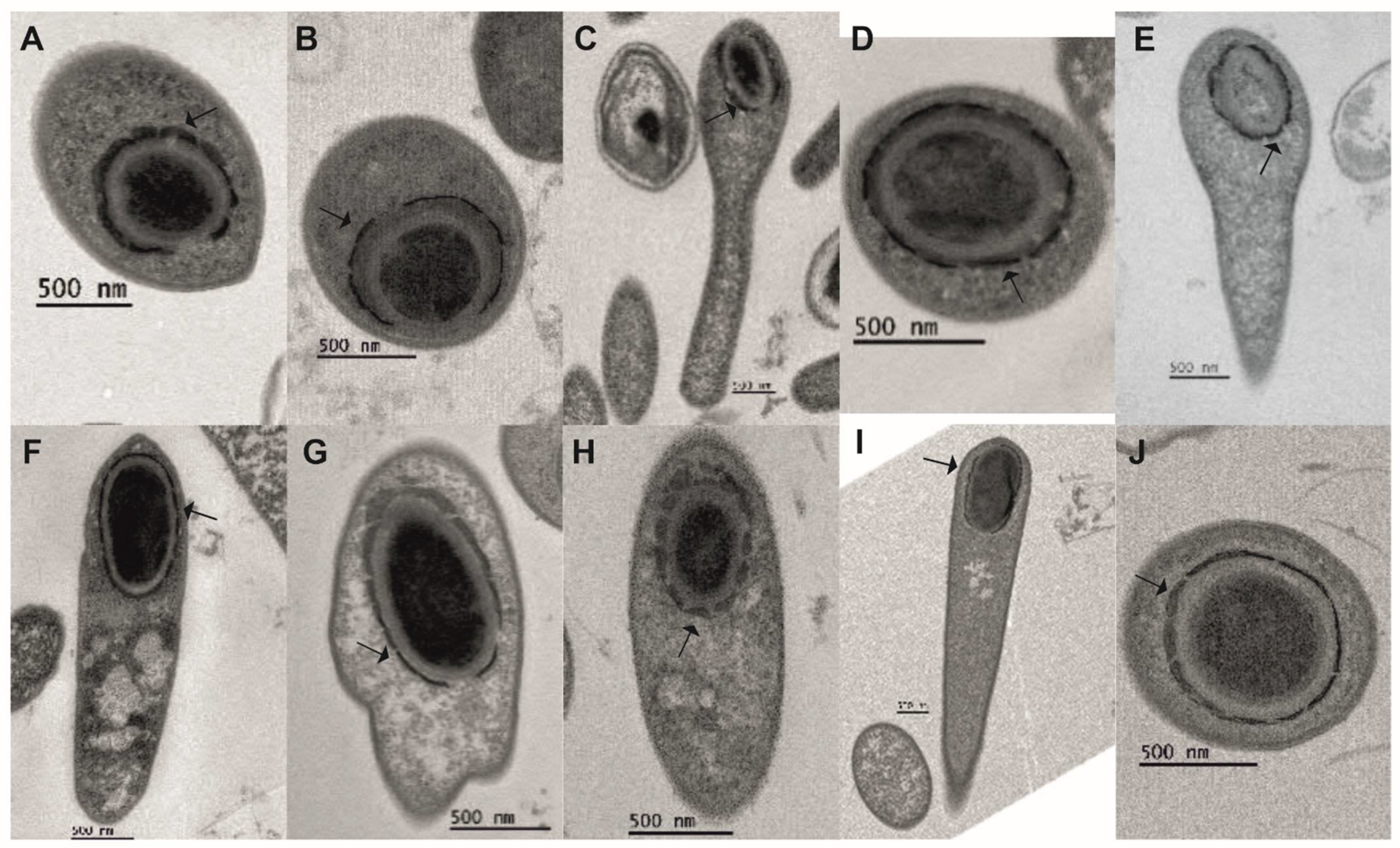
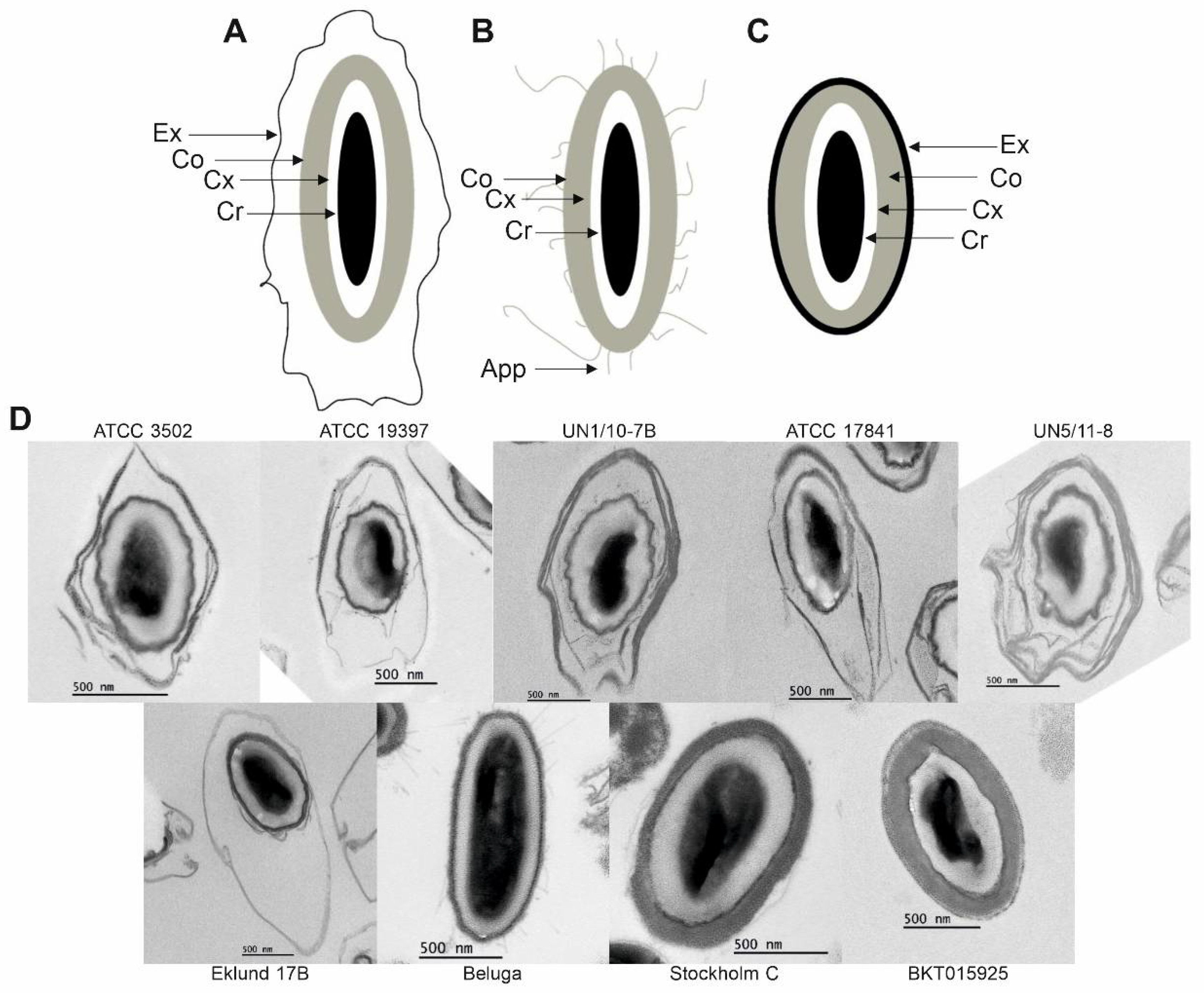

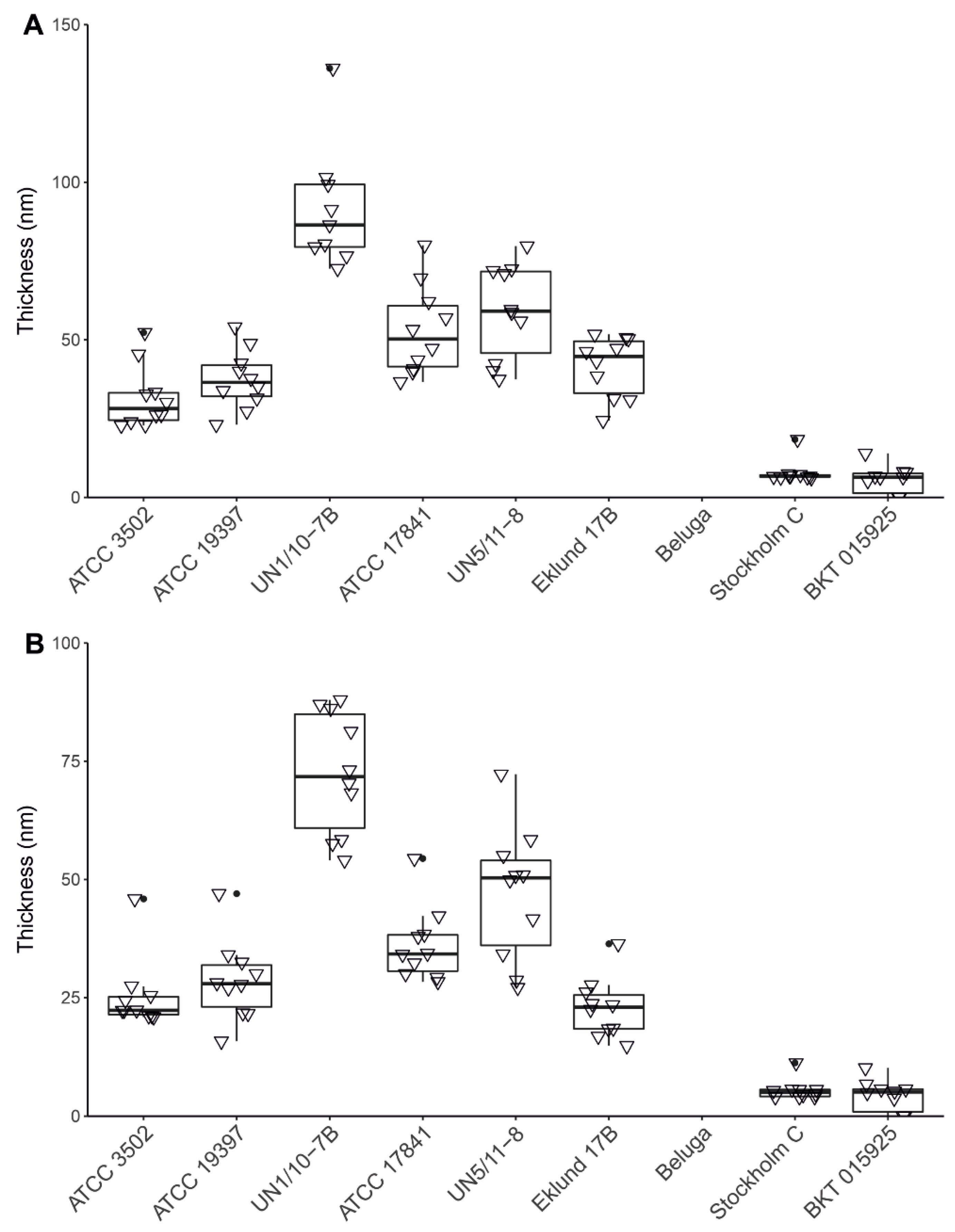
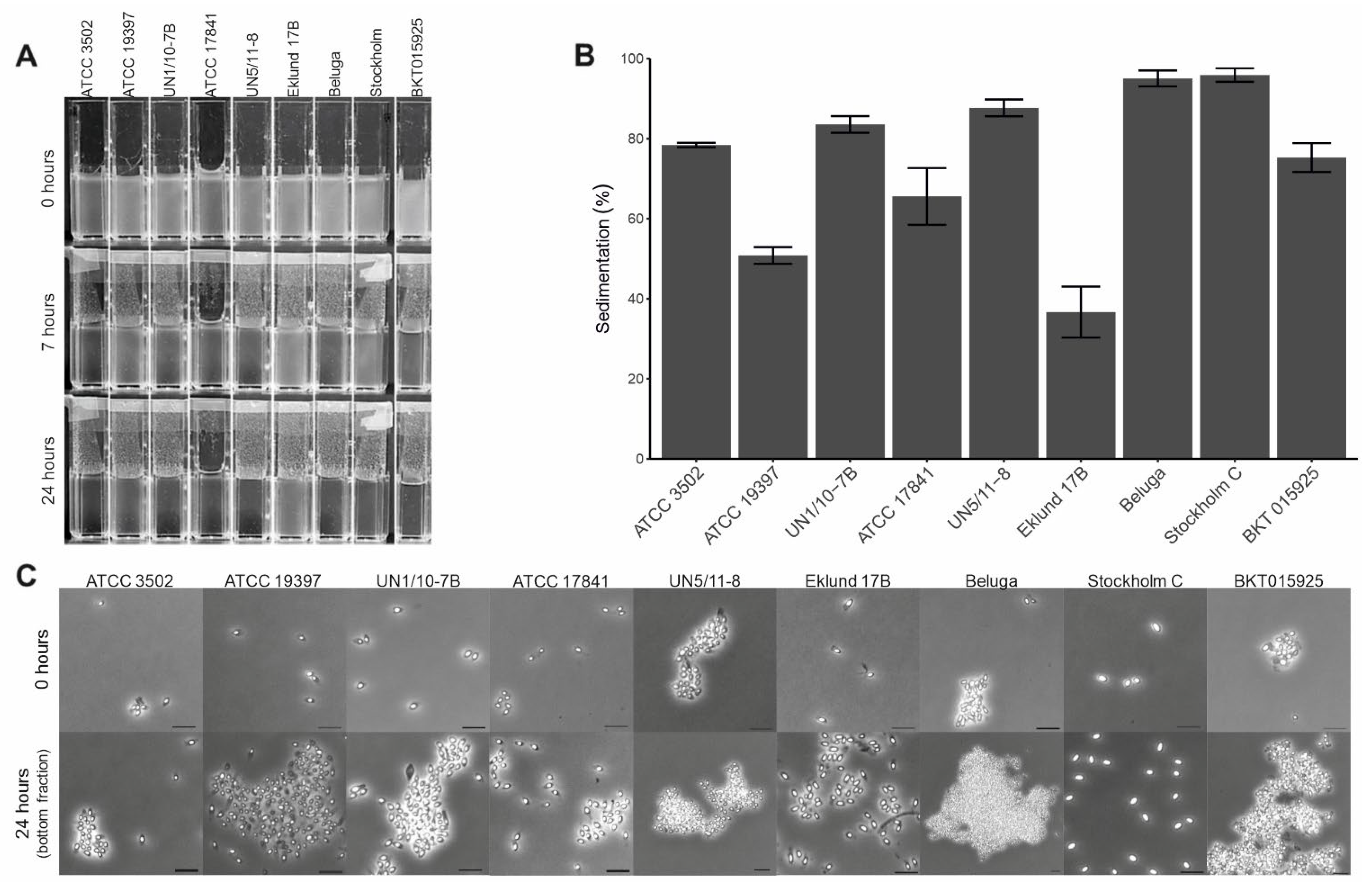
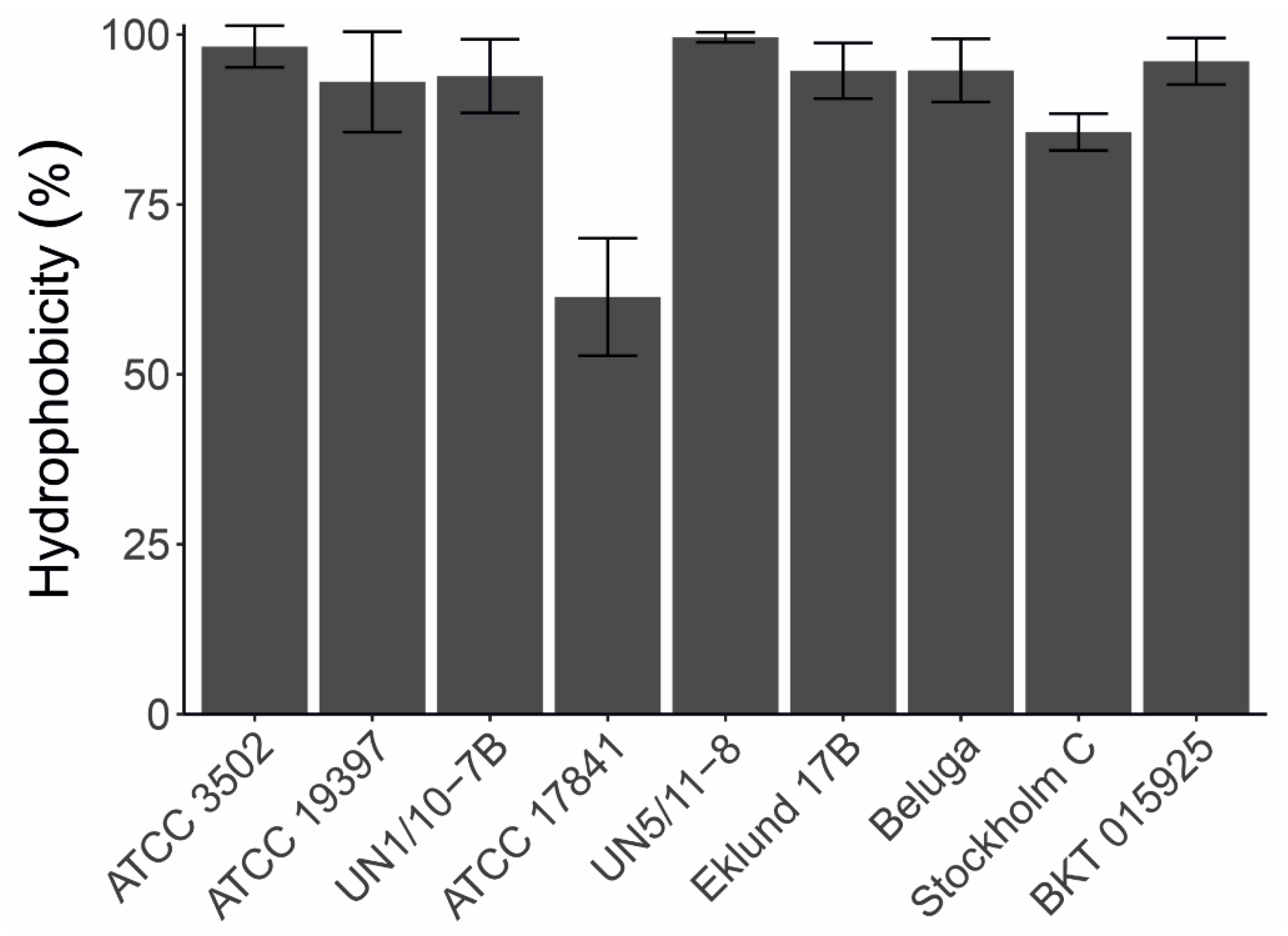
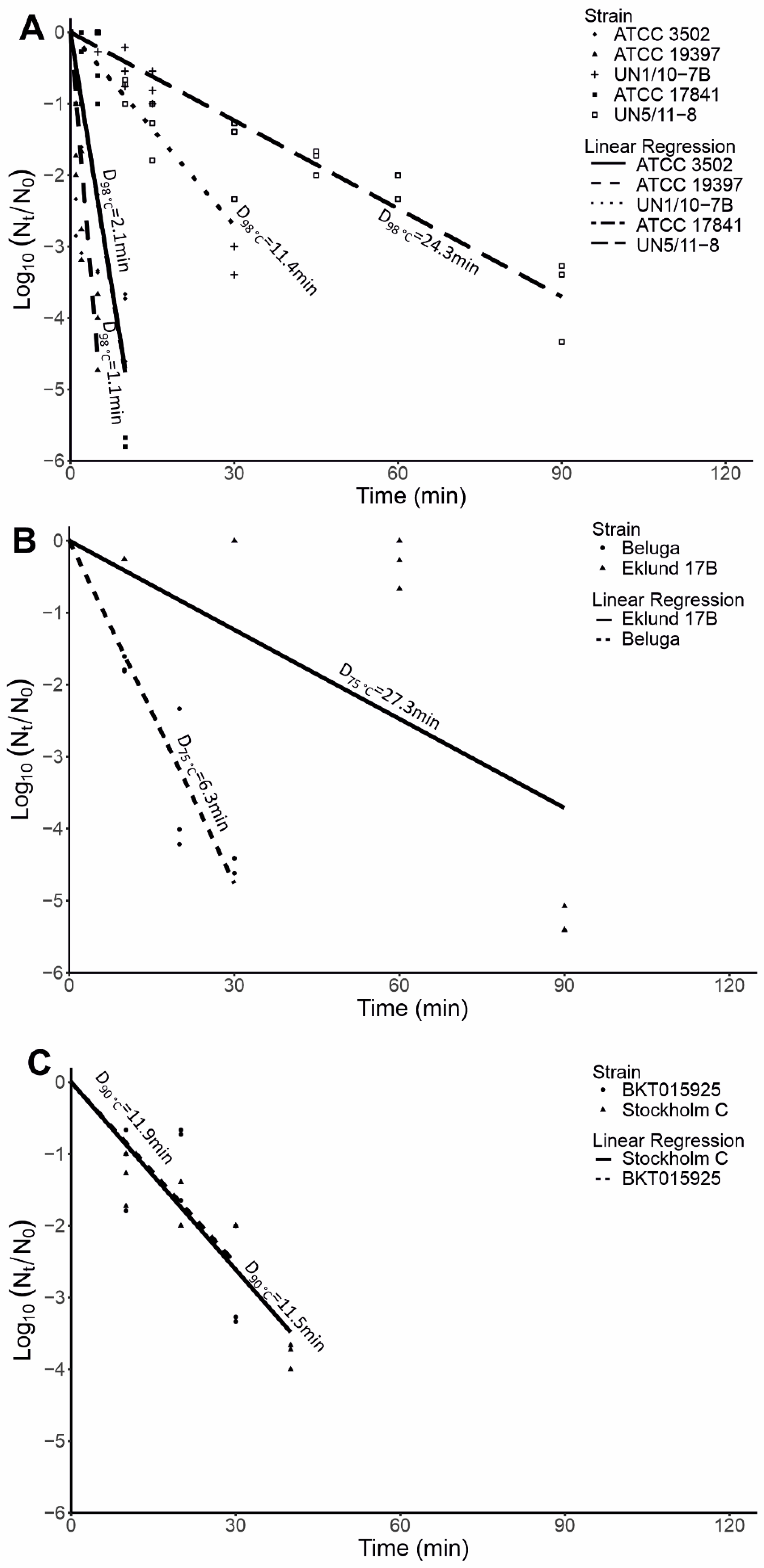
| Group | Strain | Hours | Non-Sporulating Cells | Sporulating Cells | Free Spores | Free Phase-Dark Spores | Total Cell Number |
|---|---|---|---|---|---|---|---|
| I | ATCC 3502 | 5 | 100 ± 0.0 | 0.0 ± 0.0 | 0.0 ± 0.0 | 0.0 ± 0.0 | n = 1009 |
| 24 | 96 ± 2.0 | 4.0 ± 2.0 | 0.0 ± 0.0 | 0.0 ± 0.0 | n = 1108 | ||
| 48 | 84 ± 7.1 | 16 ± 7.1 | 0.0 ± 0.0 | 0.0 ± 0.0 | n = 2484 | ||
| 72 | 79 ± 5.7 | 19 ± 5.5 | 1.4 ± 0.6 | 0.0 ± 0.0 | n = 2829 | ||
| ATCC 19397 | 5 | 100 ± 0.0 | 0.0 ± 0.0 | 0.0 ± 0.0 | 0.0 ± 0.0 | n = 798 | |
| 24 | 98 ± 0.3 | 1.2 ± 0.3 | 0.1 ± 0.2 | 0.0 ± 0.0 | n = 1127 | ||
| 48 | 95 ± 1.4 | 4.0 ± 1.2 | 0.4 ± 0.2 | 0.0 ± 0.0 | n = 1044 | ||
| 72 | 90 ± 0.7 | 6.6 ± 1.2 | 2.9 ± 0.8 | 0.0 ± 0.0 | n = 1975 | ||
| UN1/10-7B | 5 | 100 | 0.0 | 0.0 | 0.0 | n = 692 | |
| 24 | 98 | 1.8 | 0.0 | 0.0 | n = 853 | ||
| 48 | 64 | 35 | 0.4 | 0.0 | n = 716 | ||
| 72 | 50 | 48 | 0.2 | 0.0 | n = 757 | ||
| ATCC 17841 | 5 | 100 ± 0.2 | 0.0 ± 0.0 | 0.2 ± 0.2 | 0.0 ± 0.0 | n = 1636 | |
| 24 | 98 ± 1.6 | 2.1 ± 1.5 | 0.1 ± 0.1 | 0.0 ± 0.0 | n = 1281 | ||
| 48 | 75 ± 11 | 25 ± 12 | 0.2 ± 0.2 | 0.0 ± 0.0 | n = 1721 | ||
| 72 | 54 ± 21 | 42 ± 21 | 2.9 ± 1.7 | 0.3 ± 0.2 | n = 1116 | ||
| UN5/11-8 | 5 | 100 ± 0.1 | 0.0 ± 0.1 | 0.0 ± 0.0 | 0.0 ± 0.0 | n = 1553 | |
| 24 | 99 ± 0.4 | 1.0 ± 0.4 | 0.0 ± 0.0 | 0.0 ± 0.0 | n = 3510 | ||
| 48 | 88 ± 2.4 | 11 ± 2.2 | 1.3 ± 0.3 | 0.0 ± 0.0 | n = 1083 | ||
| 72 | 90 ± 1.3 | 6.8 ± 1.6 | 3.4 ± 0.4 | 0.0 ± 0.0 | n = 1219 | ||
| II | Eklund 17B | 8 | Low cell density, no pellet was obtained | ||||
| 24 | 100 ± 0.2 | 0.1 ± 0.2 | 0.0 ± 0.0 | 0.0 ± 0.0 | n = 2166 | ||
| 48 | 75 ± 4.2 | 6.8 ± 1.8 | 18 ± 5.9 | 0.1 ± 0.2 | n = 1036 | ||
| 72 | 76 ± 4.3 | 0.3 ± 0.1 | 22 ± 4.1 | 0.9 ± 0.8 | n = 1208 | ||
| Beluga | 8 | 98 ± 1.3 | 2.2 ± 1.3 | 0.0 ± 0.0 | 0.0 ± 0.0 | n = 3390 | |
| 24 | 80 ± 3.8 | 4.8 ± 1.4 | 15 ± 4.2 | 0.0 ± 0.0 | n = 831 | ||
| 48 | 38 ± 1.1 | 5.6 ± 2.2 | 56 ± 1.9 | 0.0 ± 0.0 | n = 370 | ||
| 72 | 7.7 ± 4.5 | 0.5 ± 0.9 | 75 ± 4.6 | 17 ± 7.4 | n = 550 | ||
| CB11/1-1 | 8 | Low cell density, no pellet was obtained | |||||
| 24 | 100 ± 0.0 | 0.0 ± 0.0 | 0.0 ± 0.0 | 0.0 ± 0.0 | n = 1346 | ||
| 48 | 85 ± 1.0 | 3.8 ± 1.4 | 9.0 ± 1.5 | 2.5 ± 0.6 | n = 1138 | ||
| 72 | 60 ± 18 | 1.9 ± 0.9 | 23 ± 12 | 15 ± 7.8 | n = 1130 | ||
| III | Stockholm C | 8 | 100 ± 0.0 | 0.0 ± 0.0 | 0.0 ± 0.0 | 0.0 ± 0.0 | n= § |
| 24 | 94 ± 0.5 | 3.1 ± 1.4 | 3.0 ± 1.4 | 0.0 ± 0.0 | n = 829 | ||
| 48 | 82 ± 2.6 | 7.4 ± 1.5 | 8.9 ± 1.2 | 1.5 ± 1.0 | n = 788 | ||
| 72 | 60 ± 2.2 | 11 ± 4.4 | 27 ± 3.1 | 1.2 ± 1.1 | n = 457 | ||
| BKT015925 | 8 | 100 ± 0.1 | 0.2 ± 0.1 | 0.0 ± 0.0 | 0.0 ± 0.0 | n = 2603 | |
| 24 | 94 ± 1.3 | 1.2 ± 0.8 | 4.9 ± 1.2 | 0.0 ± 0.0 | n = 899 | ||
| 48 | 65 ± 21 | 1.7 ± 0.7 | 33 ± 21 | 0.0 ± 0.0 | n = 302 | ||
| 72 | 46 ± 5.0 | 1.1 ± 2.0 | 45 ± 6.4 | 7.5 ± 6.2 | n = 427 | ||
| Group | Toxin Type | Name | Source | Proteolytic | Growth/Sporulation Media |
|---|---|---|---|---|---|
| I | A | ATCC 3502 | Historical strain, likely foodborne botulism, early 1920s (USA) [52] | Yes | TPGY |
| A | ATCC 19397 | Historical strain, likely foodborne botulism, before 1947 (USA) [52] | Yes | TPGY | |
| A | UN1/10-7B | Infant botulism, 2010 (Finland) [53] | Yes | TPGY | |
| B | ATCC 17841 | Unknown origin, ATCC collection | Yes | TPGY | |
| B | UN5/11-8 | Almond-filled, olive causing foodborne botulism, 2011 (Finland) [54] | Not known | TPGY | |
| II | B | Eklund 17B | Marine sediment, 1965 [55] | No | TPGY/CMM-TPGY |
| E | Beluga | Fermented whale flippers, 1951 (Alaska) [56] | No | TPGY/CMM-TPGY | |
| E | CB11/1-1 | Whitefish eggs causing foodborne botulism, 1999 (Finland) [57] | No | TPGY/CMM-TPGY | |
| III | C | Stockholm C | Mink farm, 1949 (Sweden) [58] | Not known | TPGY-Cys |
| CD | BKT015925 | Chicken liver, 2008 (Sweden) [51] | Not known | TPGY-Cys |
Publisher’s Note: MDPI stays neutral with regard to jurisdictional claims in published maps and institutional affiliations. |
© 2022 by the authors. Licensee MDPI, Basel, Switzerland. This article is an open access article distributed under the terms and conditions of the Creative Commons Attribution (CC BY) license (https://creativecommons.org/licenses/by/4.0/).
Share and Cite
Portinha, I.M.; Douillard, F.P.; Korkeala, H.; Lindström, M. Sporulation Strategies and Potential Role of the Exosporium in Survival and Persistence of Clostridium botulinum. Int. J. Mol. Sci. 2022, 23, 754. https://doi.org/10.3390/ijms23020754
Portinha IM, Douillard FP, Korkeala H, Lindström M. Sporulation Strategies and Potential Role of the Exosporium in Survival and Persistence of Clostridium botulinum. International Journal of Molecular Sciences. 2022; 23(2):754. https://doi.org/10.3390/ijms23020754
Chicago/Turabian StylePortinha, Inês M., François P. Douillard, Hannu Korkeala, and Miia Lindström. 2022. "Sporulation Strategies and Potential Role of the Exosporium in Survival and Persistence of Clostridium botulinum" International Journal of Molecular Sciences 23, no. 2: 754. https://doi.org/10.3390/ijms23020754
APA StylePortinha, I. M., Douillard, F. P., Korkeala, H., & Lindström, M. (2022). Sporulation Strategies and Potential Role of the Exosporium in Survival and Persistence of Clostridium botulinum. International Journal of Molecular Sciences, 23(2), 754. https://doi.org/10.3390/ijms23020754






